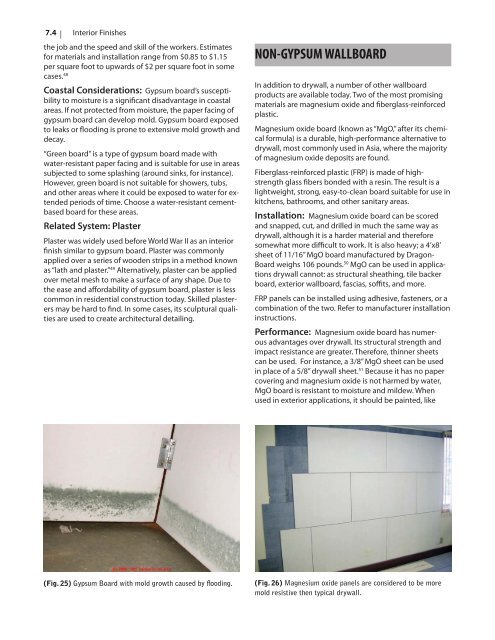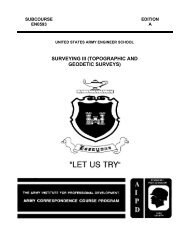Alternative Construction Research Guide - GCCDS
Alternative Construction Research Guide - GCCDS
Alternative Construction Research Guide - GCCDS
Create successful ePaper yourself
Turn your PDF publications into a flip-book with our unique Google optimized e-Paper software.
7.4 | Interior Finishesthe job and the speed and skill of the workers. Estimatesfor materials and installation range from $0.85 to $1.15per square foot to upwards of $2 per square foot in somecases. 48Coastal Considerations: Gypsum board’s susceptibilityto moisture is a significant disadvantage in coastalareas. If not protected from moisture, the paper facing ofgypsum board can develop mold. Gypsum board exposedto leaks or flooding is prone to extensive mold growth anddecay.“Green board” is a type of gypsum board made withwater-resistant paper facing and is suitable for use in areassubjected to some splashing (around sinks, for instance).However, green board is not suitable for showers, tubs,and other areas where it could be exposed to water for extendedperiods of time. Choose a water-resistant cementbasedboard for these areas.Related System: PlasterPlaster was widely used before World War II as an interiorfinish similar to gypsum board. Plaster was commonlyapplied over a series of wooden strips in a method knownas “lath and plaster.” 49 <strong>Alternative</strong>ly, plaster can be appliedover metal mesh to make a surface of any shape. Due tothe ease and affordability of gypsum board, plaster is lesscommon in residential construction today. Skilled plasterersmay be hard to find. In some cases, its sculptural qualitiesare used to create architectural detailing.NON-GYPSUM WALLBOARDIn addition to drywall, a number of other wallboardproducts are available today. Two of the most promisingmaterials are magnesium oxide and fiberglass-reinforcedplastic.Magnesium oxide board (known as “MgO,” after its chemicalformula) is a durable, high-performance alternative todrywall, most commonly used in Asia, where the majorityof magnesium oxide deposits are found.Fiberglass-reinforced plastic (FRP) is made of highstrengthglass fibers bonded with a resin. The result is alightweight, strong, easy-to-clean board suitable for use inkitchens, bathrooms, and other sanitary areas.Installation: Magnesium oxide board can be scoredand snapped, cut, and drilled in much the same way asdrywall, although it is a harder material and thereforesomewhat more difficult to work. It is also heavy; a 4’x8’sheet of 11/16” MgO board manufactured by Dragon-Board weighs 106 pounds. 50 MgO can be used in applicationsdrywall cannot: as structural sheathing, tile backerboard, exterior wallboard, fascias, soffits, and more.FRP panels can be installed using adhesive, fasteners, or acombination of the two. Refer to manufacturer installationinstructions.Performance: Magnesium oxide board has numerousadvantages over drywall. Its structural strength andimpact resistance are greater. Therefore, thinner sheetscan be used. For instance, a 3/8” MgO sheet can be usedin place of a 5/8” drywall sheet. 51 Because it has no papercovering and magnesium oxide is not harmed by water,MgO board is resistant to moisture and mildew. Whenused in exterior applications, it should be painted, like(Fig. 25) Gypsum Board with mold growth caused by flooding.(Fig. 26) Magnesium oxide panels are considered to be moremold resistive then typical drywall.
















